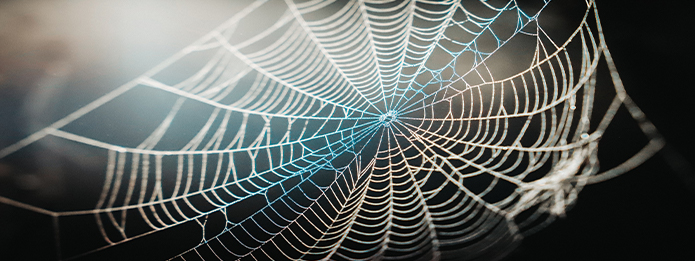Spider Webs: Identify A Spider By What They Weave

While many people dislike knowing that a spider is nearby, their presence isn’t usually a reason for fear. Spiders play an important part in the ecosystem and help prey on bugs and insects that may otherwise make their way into your home or living spaces.
However, there are some poisonous spiders whose bite could cause a significant health impact on the bitten. You may not always spot these spiders in the open, but you can usually recognize their presence through the type of web they weave.
Funnel Web
You won’t find a funnel web inside your home, but you may see it in the grassy areas surrounding your home. These webs can cover a large expanse and can resemble pulled strands of cotton with a hole in the middle. The hole, or funnel, is where the spider lives.
Most funnel-weaving spiders are not dangerous. The one notable exception is the hobo spider. They are a type of funnel-weaving spider whose bite is poisonous to humans and pets.
Mesh Web
Mesh webs, also called tangle webs, are similar to cobwebs but are found outside under leaves and rocks. While there is some order to their crafting, they can look chaotic in their final form. This haphazard nature makes it easy for bugs and insects to become entangled and trapped within the three-dimensional web.
Spiders that weave mesh webs aren’t dangerous. However, mesh webs can resemble tangle webs, which are built by black widows.
Orb Web
When you picture a spider web, you’re likely thinking of an orb web. Circular in nature, it’s comprised of multiple spokes with the outer thread serving as the strong supporting frame. The interior designs can be either intricate or simple. Regardless, though, they serve as an excellent trap for flying insects.
Orb web weavers tend not to be dangerous to humans or pets. They can, however, catch up to 250 insects a day.
Sheet Web
If you take the orb web and turn it horizontal, you’ll have a sheet web. Unlike other spider webs, these tend to be permanent structures that necessitate frequent repairs and patches due to damage from the weather or animals.
The spiders that weave these webs tend to be on the smaller side. They also don’t pose any threat to humans or pets.
Tangle Web
Tangle webs resemble mesh webs due to their disorganized nature. They collect dirt and dust and can appear to look like cobwebs, too. However, a tangle web will often attach itself to the top of a structure and have several threads of different length dangling down from it.
It’s important to be aware of tangle webs near or inside your home. While most tangle web weavers are harmless house spiders, this type of spider also includes the black widow, which is marked with an orange hourglass shape figure on its body.
Triangle Web
A triangle web is a simple construction whose geometric shape consists of three strands of silk with a simple weave across the threads. Unlike other silk threads, the ones in the triangle web are fuzzy and work to catch and smother insects.
The family of spiders associated with the triangle web is unique. They lack venom glands, which is why they use their web, instead of their bite, to kill their prey. Due to this, they aren’t harmful to humans or other animals.
Spider Control Services
While many spiders serve a useful purpose in or near a home, there are times when their presence becomes too much. This is especially true if the spiders are poisonous, such as the black widow, brown recluse, or hobo spider.
Contact Truly Nolen today so we can assess your spider situation and enact a plan that safely removes them from your home. We also provide seasonal preventative services that take into account the changing behaviours of spiders and other pests as the year progresses.